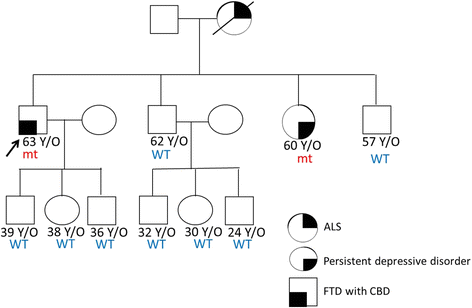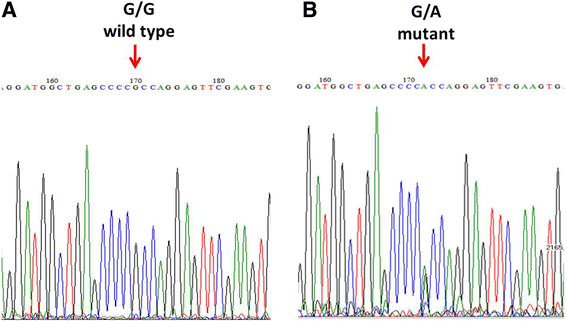Intrafamilial phenotypic heterogeneity in a Taiwanese family with a MAPT p.R5H mutation: a case report and literature review
- PMID: 28923025
- PMCID: PMC5604294
- DOI: 10.1186/s12883-017-0966-3
Intrafamilial phenotypic heterogeneity in a Taiwanese family with a MAPT p.R5H mutation: a case report and literature review
Abstract
Background: Frontotemporal degeneration (FTD) is a clinically and genetically heterogeneous neurodegenerative disorder characterized by deficits in executive function that frequently overlaps with parkinsonism and motor neuron disorders. Several genes have been identified to cause autosomal dominant forms of FTD, including the gene coding for the protein associated with microtubule tau (MAPT). While most reported pathogenic mutations in MAPT occur in exons 9-13, few families have been reported with mutations outside of this region. Herein, we report a first Taiwanese family having the exon 1 p.Arg5His mutation in MAPT with intrafamilial phenotype heterogeneity.
Case presentation: A 63-year-old man presented with progressive non-fluent speech and impaired memory for 3 years. He then developed apraxia, myoclonus and parkinsonism feature at his right hand. Extensive neurologic and neurocognitive examination lead to a diagnosis of FTD mixed with corticobasal syndrome. Magnetic resonance imaging revealed asymmetric atrophy in the left frontal and temporal lobes and single-photon emission computed tomography indicated decreased metabolism in the same areas as well as the left basal ganglia. The patient's mother had been diagnosed with amyotrophic lateral sclerosis (ALS) at the age of 60 and was deceased 10 years later due to respiratory failure. The patient's younger sister had persistent depressive disorder in her early forties and did not have any prominent cognitive or motor dysfunctions. We performed genetic analysis applying a targeted next generation sequencing (NGS) panel covering MAPT, GRN, VCP, FUS, CHMP2B, and TARDBP on the proband, followed by Sanger sequencing of candidate genes in eight family members. Hexanucleotide repeat expansion of C9Orf72 was determined by repeat-primed PCR. We identified a missense mutation in exon 1 of MAPT gene, c.14G > A (p.R5H), which was previously reported in only two Japanese patients in a literature review. This substitution co-segregated with the disease phenotypes in the family.
Conclusions: This is the first report of the occurrence of the MAPT p.R5H mutation in the Taiwanese population. Our findings extend the current knowledge of phenotypic heterogeneity among family members carrying the MAPT p.R5H mutation.
Keywords: Amyotrophic lateral sclerosis; Corticobasal syndrome; Depression; Frontotemporal dementia; Microtubule-associated protein tau; Primary progressive aphasia.
Conflict of interest statement
Ethics approval and consent to participate
This study was approved by the institutional review board of National Taiwan University Hospital and all study participants gave their informed consent before inclusion in the study. This study was performed in accordance with the Declaration of Helsinki, and all authors agree to the Publish Statements of BMC Neurology. All authors have no competing interests or conflicts of interest to declare.
Consent for publication
Written informed consent was obtained from the index patient and his family members for publication of this case report and any accompanying tables/images. A copy of the written consent is available for review by the Editor of this journal.
Competing interests
The authors declare that they have no competing interests.
Publisher’s Note
Springer Nature remains neutral with regard to jurisdictional claims in published maps and institutional affiliations.
Figures



References
Publication types
MeSH terms
Substances
LinkOut - more resources
Full Text Sources
Other Literature Sources
Miscellaneous

